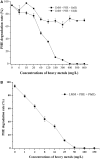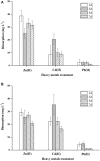Biodegradation of Phenanthrene and Heavy Metal Removal by Acid-Tolerant Burkholderia fungorum FM-2
- PMID: 30930861
- PMCID: PMC6427951
- DOI: 10.3389/fmicb.2019.00408
Biodegradation of Phenanthrene and Heavy Metal Removal by Acid-Tolerant Burkholderia fungorum FM-2
Abstract
Phenanthrene (PHE) is a common pollutant of acidic and non-acidic environments that is recalcitrant to biodegradation. Herein, Burkholderia fungorum FM-2 (GenBank accession no. KM263605) was isolated from oil-contaminated soil in Xinjiang and characterized morphologically, physiologically, and phylogenetically. Environmental parameters including PHE concentration, pH, temperature, and salinity were optimized, and heavy metal tolerance was investigated. The MIC of strain FM-2 tolerant to Pb(II) and Cd(II) was 50 and 400 mg L-1, respectively, while the MIC of Zn(II) was >1,200 mg L-1. Atypically for a B. fungorum strain, FM-2 utilized PHE (300 mg L-1) as a sole carbon source over a wide pH range (between pH 3 and 9). PHE and heavy metal metabolism were assessed using gas chromatography (GC), inductively coupled plasma optical emission spectroscopy (ICP-OES), scanning electron microscopy-energy dispersive X-ray spectroscopy (SEM-EDS), Fourier-transform infrared (FTIR) spectroscopy and ultraviolet (UV) absorption spectrometry. The effects of heavy metals on the bioremediation of PHE in soil were investigated, and the findings suggest that FM-2 has potential for combined bioremediation of soils co-contaminated with PHE and heavy metals.
Keywords: Burkholderia fungorum; acid-tolerant bacteria; bioremediation; heavy metal resistance; phenanthrene biodegradation.
Figures








References
-
- Abou-Shanab R. A., van Berkum P., Angle J. S. (2007). Heavy metal resistance and genotypic analysis of metal resistance genes in gram-positive and gram-negative bacteria present in Ni-rich serpentine soil and in the rhizosphere of Alyssum murale. Chemosphere. 68, 360–367. 10.1016/j.chemosphere.2006.12.051 - DOI - PubMed
-
- Al-Thukair A. A., Malik K. (2016). Pyrene metabolism by the novel bacterial strains Burkholderia fungorum (T3A13001) and Caulobacter sp (T2A12002) isolated from an oil-polluted site in the Arabian Gulf. Int. Biodeterior. Biodegradation. 110, 32–37. 10.1016/j.ibiod.2016.02.005 - DOI
LinkOut - more resources
Full Text Sources
Molecular Biology Databases
Miscellaneous

